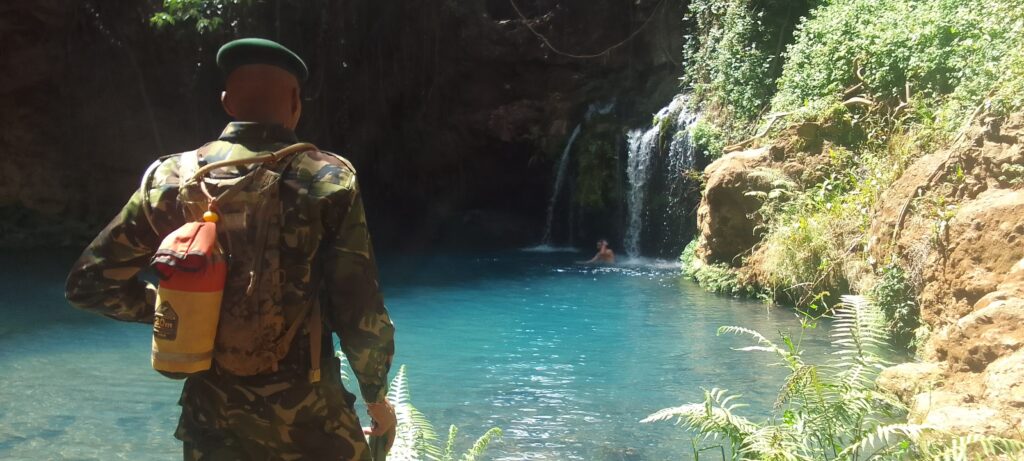MERU, Kenya- “I can confirm that life is different now. Things may never be the same again,” says Samson Githinji, a horticulture farmer.
Githinji has lived his whole life in Timau, on the slopes of Mt Kenya.
The area is famous for its trekking trails through pristine forests and river valleys, and it is located next to the snowcapped glaciers of Mt Kenya.
However, this scenery is quickly melting away. Literally.
Based on scientific research, the glaciers atop Mt Kenya have shrunk by almost 45% over the past century.
Communities are at risk as these once-reliable freshwater reservoirs are already depleting alarmingly.
When this writer recently visited the mountainous region, Githinji recalled heavy snowfall in the mountains not too long ago, and the glaciers were “white and big.”
For much of his life, keeping livestock and growing various crops was easy.
But with warming temperatures, the amount of water and fresh grass available for the animals has diminished rapidly.
“Move around here, and even livestock farmers and wildlife conservancies will confidently confirm that there is not enough grass to feed them anymore. All the farmers face the same problem,” he says.
The tallest mountain in Kenya and the second-highest in Africa is Mt Kenya.
Even from 150 kilometres away from Nairobi, the mountain in Meru county is an imposing sight.
The mountain’s name is derived from the Akamba words that mean “shine” or “glitter,” honouring the enduring snow crowns that used to be its distinguishing characteristic.
The glaciers that earned the mountain its name are currently receding quickly.
The United Nations Environment Program (UNEP) reports that only 10 of the 18 glaciers that covered the summit of Mount Kenya a century ago are still present.
It is also possible that Mt Kenya will lose its ice cover in the next 25 years due to rising temperatures; this is a sign of the broader effects that climate change is having in the area.
Although Africa contributes only 4% of the world’s current greenhouse gas emissions, 65% of its population is directly impacted by climate change.
Intense floods in Kenya between March and May 2024 claimed over 250 lives and forced over 250,000 more to flee their homes.
The floods occurred as many were beginning to recover from the famine and drought that had ravaged the region. These conditions put pressure on economic growth, slowed crop output in Kenya, and raised food prices.
Following years of reduction, hunger and undernutrition are on the rise in Africa, where 257 million people, or one-fifth of the population, are undernourished.
A major contributing reason to this trend is the deterioration of environmental conditions and climate extremes.
The hardships locals face in the region every day are disclosed by livestock farmer Abdi Mohammed of Manyagalo village in Maua Meru county:
“We depended on resources such as the Ngare Ndare River for irrigation and drinking water. However, due to the melting glaciers of Mt Kenya, the river, with its source in Mt Kenya, now needs help to sustain the communities of Isiolo, Laikipia, and Meru counties. Currently, we get water once every five days. Both our livestock and our crops are suffering, wilting.”

The neighbouring villages are filled with the sound of Abdi’s and many others’ sufferings.
Another farmer, Martin Kinoti, provides an even more vivid image of their adaptation attempts:
“We’ve embraced zero grazing to save water, but even that is not enough. Our ability to produce milk has declined. Desperate for any vegetation, our animals graze alongside nature. It’s a fight for existence.”
The residents maintain that the melting glaciers atop Mt Kenya are the primary cause of this issue.
When contacted for comment, John Madadi, the head of Keitt Exporters Limited’s division for mangoes and vegetables, stated that climate change has significantly impacted their contracted farmers in the Mt Kenya area.
“The mountain used to have rich vegetation, and when the snow melted, it would fall and form springs, which would help the farmers downstream. However, lately, the heat has caused the amount of snow to diminish. This has impacted our farms,” Madadi said.
He said that, for example, a farmer who used to be able to produce five tons of product now manages only three tonnes due to inadequate watering of his field.
“Pesticides and other agricultural chemicals can only be absorbed by a crop through water in this type of cultivation. The crops have difficulty growing with insufficient water,” Madadi stated.
Madadi claims this is the rationale behind the company’s collaboration with farmers to guarantee they preserve the environment by planting trees.
The Nature Conservancy’s Agriculture Director for Africa, Michael Misiko, guides the future:
“Water use efficiency is critical. We must use water-saving irrigation techniques. The battle for water resources between farmers and pastoralists is getting more intense. Prudent water management can lessen these confrontations.”
A creative approach is required, according to Laikipia County agriculture officer Magret Wamboi, who states:
“We are enhancing drip irrigation and water storage by creating water pans. Water-efficient farming techniques are essential to human survival.”

Work is being done in the meantime to conserve what’s left. Working with the local community, the Lewa Wildlife Conservancy constructed a 100,000-liter water tank in Maua to provide a short-term solution.
In the meantime, there is an obvious and growing climate risk, particularly for Africa, as seen from the case of Mt Kenya.
However, it is also evident that Africa has much to offer regarding leadership, the private sector’s ingenuity, and citizens’ fervour for audacious climate action.
While Africa is experiencing the worst effects of climate change, it is also leading the way in developing some of the most innovative remedies.



